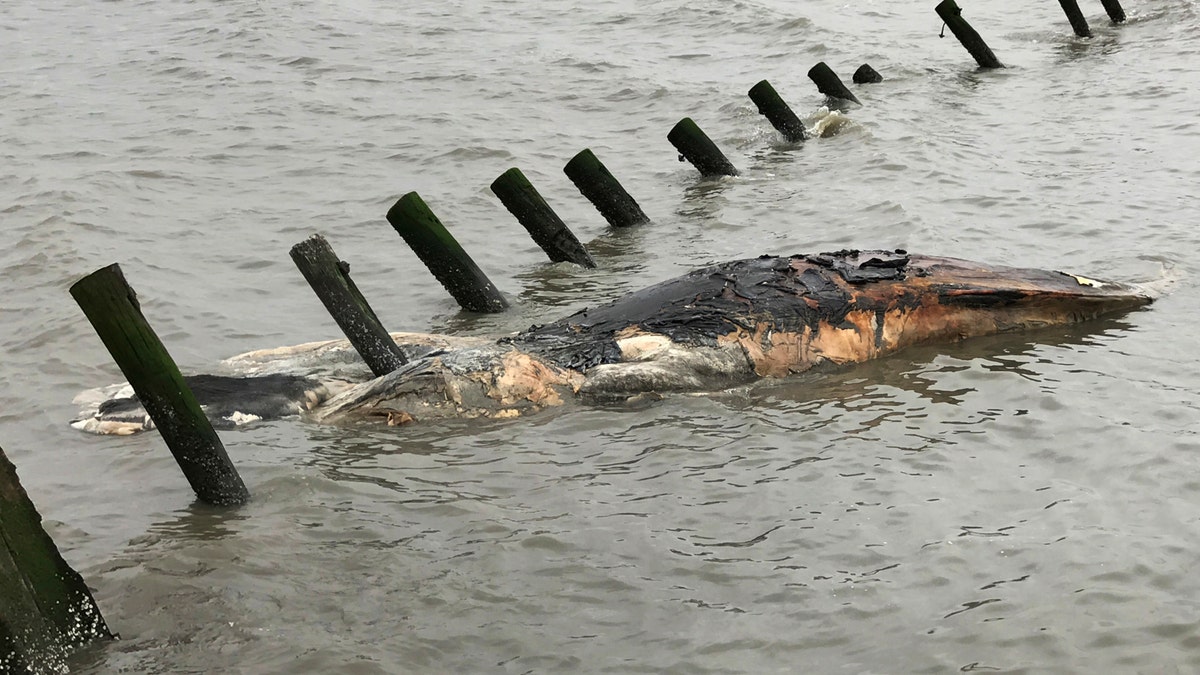
This April 24, 2017 photo provided by MERR Institute, Inc. shows a dead humpback whale at Port Mahon, Del. Federal officials said humpback whales have been dying in unusually large numbers along the Atlantic Coast. (Suzanne Thurman/MERR Institute, Inc. via AP)
Humpback whales are dying at an alarming rate off America's East Coast with more than 40 washing ashore in little over a year, and U.S. scientists are investigating why it is happening.
An “unusual mortality event” has been declared for East Coast humpback whales, defined as "a stranding that is unexpected; involves a significant die-off of any marine mammal population; and demands immediate response.” Stranding, in this case, means the whale has died.
In response to a large increase in the humpback whale death toll along the Eastern Seaboard, the National Oceanic and Atmospheric Administration (NOAA) announced an investigation on Thursday into the deaths, which have been occurring on the Atlantic coast, stretching from Maine to North Carolina.
Last week, a dead, decomposing humpback whale washed ashore in Delaware, making it the 42nd death in the region since the beginning of 2016.
Jennifer Goebel, a spokesperson for NOAA Fisheries Greater Atlantic Region, told Fox News that they would categorize this as unusual.
“This number is over and above what we would consider normal and expected,” she explained.
Since 2000, the number of humpback deaths in the Atlantic region has averaged 15 per year. Goebel pointed out that “not all of these are known to be human-caused mortalities” meaning they were not necessarily killed, adding that “whales may die for other reasons.”
NOAA website names several of the greatest known threats to humpback whales: the entanglement in fishing gear, ship strikes, whale watch harassment, habitat impacts, and harvest.
North Carolina had the highest number of stranded humpbacks, including 5 in 2016, and a total of 6 dead already in 2017. In addition to Delaware and North Carolina, the rest of the 42 deaths occurred in Massachusetts, Maryland, Maine, New Hampshire, New Jersey, New York, Rhode Island, and Virginia.
A newborn humpback whale weights around one ton and measures about 15 feet long. As an adult, the marine mammal can grow to up to 60 feet long and weigh in at 40 tons. Females are larger the males, and the species has a 50 year lifespan. According to NOAA’s website, the majestic creatures are considered “the favorite of whale watchers, as they frequently perform aerial displays, such as breaching (jumping out of the water), or slapping the surface with their pectoral fins, tails, or heads.”
Images of the stranded, dead whales are disturbing, and NOAA plans to get to the bottom of the crisis.
Goebel said NOAA hopes the investigation will allow experts to “gain some insight into the causes and factors that may be contributing to this unusually high number of humpback whale mortalities.”
“We can confirm that 10 of the 20 whales necropsied showed signs of having been struck by a vessel, and that the vessel strike was the cause of death,” she shared.
“However, for the other 10, we don't have definitive causes. That is also the case for the 21 (now 22 as of this morning) that we did not necropsy. We don't have any theories at this time as to why the numbers have increased so dramatically over the last year and four months, but we hope that the UME investigation will shed some light on the causes.”
The answer may lie in a variety of potential factors. “There may be changes in prey distribution that may be affecting where the whales are, and that may be contributing to a change in the whales' distribution,” Goebel said. “Or there could be some other factors at work.”
Asked if NOAA expects this alarming trend to continue, Goebel admitted that it’s hard to say without knowing the cause of the increase in humpback deaths, but they hope not.